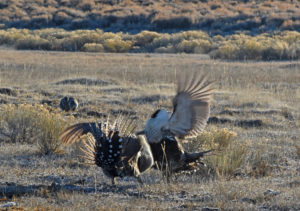For immediate release September 22, 2021
Media contacts:
Jonathan Ratner, Western Watersheds Project (877)746-3628; jonathan@westernwatersheds.org
Kristin Combs, Wyoming Wildlife Advocates (307) 413-4116; kristin@wyowild.org
Connie Wilbert, Sierra Club (307) 460-8046; connie.wilbert@sierraclub.org
Clint Nagel, Gallatin Wildlife Association, 406-600-1792; clint_nagel@yahoo.com
CHEYENNE, Wyo. – Yesterday, a Wyoming federal court agreed with environmental plaintiffs that the supplemental winter feeding of elk on the Bridger-Teton National Forest must receive additional environmental analysis. The court found that the agency improperly permitted feeding elk on two of the three feedgrounds under review, and that the claims made by the agency in defending its decision were “unpersuasive,” “implausible,” and “unreasonable.”
Sierra Club, Western Watersheds Project, Wyoming Wildlife Advocates, and the Gallatin Wildlife Association challenged the United States Forest Service for continued permitting of winter elk feeding at the Alkali Creek feedground in the Gros Ventre drainage, Dell Creek feedground in Sublette County and Forest Park feedground in Lincoln County without appropriate analysis of the harmful impacts of feeding on wildlife, including the increased risk of transmission of lethal chronic wasting disease on feedgrounds.
Chronic wasting disease is an incurable and always fatal disease that affects the central nervous system of elk, deer, and moose. The court specifically noted that the risk of transmission of chronic wasting disease at feedgrounds poses a clear danger to area wildlife, stating, “While there were no CWD detections at Forest Park, Dell Creek or Alkali Creek to date, there is no dispute that ‘congregating elk at very high densities at feedgrounds is likely to increase the spread of disease because of an increased number and rate of potential infectious contacts with infected individuals and an infected environment.’”
“These feedgrounds primarily benefit the region’s livestock operators who don’t want native wildlife spreading out among the low elevation areas and competing with their cattle for forage,” said Jonathan Ratner, Wyoming director of Western Watersheds Project. “Placating the ranchers by concentrating elk in small areas and creating their reliance on feedgrounds is both outdated and risks chronic wasting disease outbreaks throughout the Yellowstone ecosystem. We hope today’s court decision is a wake-up call to the Forest Service to bring the Forest into the 21st century.”
“Even with fatal chronic wasting disease now surrounding all three of these elk feedgrounds, the Forest Service has continued to ignore science, ignore legal directives, and put Wyoming wildlife at grave risk of catastrophic disease outbreaks,” said Connie Wilbert, Director of Sierra Club Wyoming. “This court decision makes it explicitly clear that the Forest Service can no longer simply ignore the devastating impacts that a chronic wasting disease epidemic centered on feedgrounds could have on elk herds throughout northwestern Wyoming.”
“This is the second time in three years that a federal court has found the Forest Service’s supplemental feeding activities in the Bridger-Teton National Forest unlawful. This is a serious and recurring problem that needs addressed immediately. It’s time for the Forest Service to stop permitting feedgrounds without any analysis or review of the role feedgrounds play in disease transmission and overall health of Wyoming’s elk. It’s time to put wildlife first,” said Kristin Combs, Executive Director of Wyoming Wildlife Advocates.
“It’s time we manage our wildlife with the health and welfare concern they deserve. That has been the responsibility of the U.S. Forest Service since its establishment, but what this decision tells us, the U.S. Forest Service has not been doing that”, said Clint Nagel, President of the Gallatin Wildlife Association. “Basically, the agency has been sacrificing our wildlife for the benefit of others and that is contrary to their mission. We believe it is morally wrong to congregate wildlife in an artificial setting that endangers their survival.”
The Bridger-Teton National Forest occupies the traditional lands of the Shoshone-Bannock, Eastern Shoshone and Cheyenne people.
The parties are represented by attorneys from the public interest law firm Eubanks and Associates, PLLC.
###






